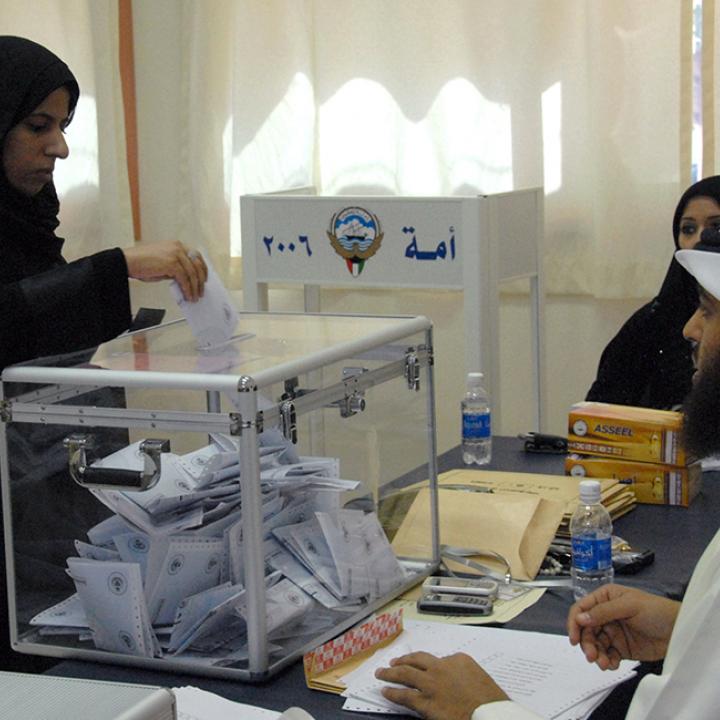

Since the death of Kuwait’s first tyrant in 1915, Mubarak, Kuwait has been ruled by two of his sons Jaber and Salem and their descendants. The harmonious alternation between Jaber and Salem, branches of the ruling family stood until 2006 when Saad al-Abdullah ruled Kuwait for nine days and was voted out of office by the parliament due to health concerns. As a result, it led to the coronation of the current Emir, Jaber. This seems to have ended the harmony between Jaber and Salem branches, and narrowed the rule further within the Jaber branch to the descendants of Ahmed son of Jaber, the most ruthless tyrant in Kuwait’s history. The current ruler of Kuwait Sabah al-Ahmed is considered by many as the last strong ruler in the House of Sabah, appointed his half-brother Nawaf as his Crown Prince. Nawaf is a weakling, in poor health, and reportedly disinterested in becoming a ruler. This eventually empty throne has stimulated both domestic and regional rivalries.
The domestic front has gone through many phases, and it still is too volatile to analyze intelligently. However, I will attempt to give a snapshot of the current state, neglecting, as much as possible, previous stages. The front-runner to be the next Crown Prince, whether when Nawaf becomes Emir, or when he gives up his post as Crown Prince due to “health-related reasons,” is his other half-brother Mishaal, the youngest son of Ahmed the Tyrant. Mishaal is the traditional choice of the ruling family, which has always preferred to elect its successors based on a hierarchy of age and kinship. Right now, Mishaal seems to have secured a consensus of most of the branches of the family. He is currently serving as the deputy chief of the national guard. He has made very few public appearances, but he doesn’t enjoy much popular support. Mishaal tops the list of candidates based on the equilibrium of forces that he played almost no role in. He had a kidney transplant a couple of years back and maybe nudged off the top at any moment.
The second hopeful sheikh is Nasser al-Sabah, the son of the current Emir. Nasser does not seem to be in a hurry, and he is taking a two-step approach aiming to rule after his uncle Mishaal. Nasser is a relative newcomer to the public domain, which is playing to his advantage as he has no prior political conflicts and he seems to get along fine with everybody on the political scene. He was received positively by the public when he made his debut as a deputy prime minister and minister of defense on December 11, 2017, as his first governmental appointment. Lack of alternatives and popular thirst for a “leader” that may change the country’s fortunes for the better and be agent provocateur seems to be playing to Nasser’s favor.
Nasser al-Mohammed is a former prime minister. Once, the third in line to the throne who was ousted by the public outcry against his flagrant corruption and incompetence. Although he has left his post injured and with unrepairable reputation, he has also left with deeply rooted power and an amassed wealth that can be used to force a near-impossible comeback. Al Mohammed still controls the close circles around the Emir, the top echelons of the judiciary, significant blocs in the parliament including its powerful chairman, many media outlets, and almost unlimited financial resources. He also enjoys significant support among the Shiite population.
The final sheikh I want to discuss is Ahmad al- Fahad. This once all-powerful “young” man is now a remnant ruin. He has bet everything he had on one duel with his, then, only rival Al Mohammed, but then did not seem to have the testosterone to pull the trigger and lost it all. However, I would never write him entirely off, mostly due to the weakness of his rivals. Ahmed still enjoys a degree of support among the tribal opposition and Islamist groups, although his support is diminishing as time goes on.
The regional front is much simpler to read. Nobody seems to like Mishaal. Iran is sticking with its longtime ally Nasser al-Mohammed. Qatar, for now, is stuck with Ahmed, and the new KSA-UAE loose-cannon of an alliance seems to have placed its bet on Nasser al-Sabah.
One more fun twist happened with this story when Nasser al-Mohammed used his considerable influence in the judiciary to channel a landmark case of seventy activists who are strongly linked to his removal from office in 2011, to one specific corrupt judge in the court of appeals. This judge, Ali al-Duraie who is a Shiite, had sexually assaulted a female attorney in the courthouse, but her complaint was buried by the head of the court appeals, Mohammed Bin Naji. Bin Naji, then used his leverage over the al-Duraie to push him to issue a ridiculously harsh verdict against the activists, which serves two main purposes. First, it will be used as a bargaining chip to get a pardon for the recently convicted Hezbollah cell. And in fact, some pro-Iranian Shiite MPs have already called for Emiry pardon for both sides on the grounds of strengthening the internal front.
The second purpose of the outrageous court ruling, is that among the seventy activists are eleven opposition MPs and former MPs and many other prominent opposition leaders, and imprisoning such a large number of public opinion leaders in this unexpected manner is bound to plunge the country into political chaos which may disrupt the seemingly settled succession race, giving more space for al-Mohammed’s team to maneuver their way out of their unfortunate spot.
In conclusion, this cold war of sheikhs is far from over, and snapshots taken of it may vary greatly if they are taken a few months apart. The situation in Kuwait will remain chaotic and potentially violent until the current Emir is dead and the next is sworn in and has named his Crown Prince.
